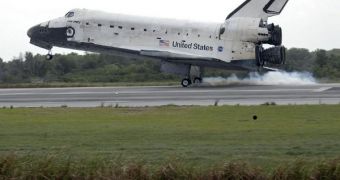At 3:13:17 pm EDT (1913:17 GMT) on Saturday, the Discovery STS-119 mission to the International Space Station (ISS) landed successfully at the Kennedy Space Center in Florida. Its mission was deemed an astounding success, as the joint crew of NASA's veteran shuttle and that of the ISS managed to install the last batch of US-built solar arrays on the orbital lab, and also performed a series of spacewalks, designed to replace some scientific experiments and to install new ones.
In addition, upon reentry, the shuttle also conducted a very important test, as its heat shield had been outfitted with a “speed bump,” a device meant to measure air friction and flow. Engineers at the American space agency and the Purdue University collaborated for this part of the mission, which they hope will provide them with new readings to take into account while constructing the heat shield for the next-generation spacecraft, the Orion Crew Vehicle.
Also, the space shuttle brought back home NASA astronaut Sandra Magnus, who has spent 134 days in orbit, aboard the ISS. She was replaced by the first long-term Japanese resident on the station, JAXA flight expert Koichi Wakata. He is a part of the Expedition 19 crew, which was also reunited on the space lab on Saturday, when the Soyuz TMA-14 mission completed its docking procedure. “I'm looking forward to being home and seeing everyone today, hopefully,” said Magnus on Saturday.
“Welcome home Discovery after a great mission to bring the International Space Station to full power,” said astronaut George Zamka, an expert from Mission Control, as the shuttle was descending on the KSC runaway. “Thank you very much, it is good to be back home,” replied the commander of the shuttle flight, Lee Archambault. Everyone was a bit on edge last week, as the shuttle orbited the planet from Wednesday to Saturday. The astronauts aboard carried out a heat shield inspection, and the air was tense until the “all clear” signal was passed on.
Thanks to the joint efforts on the part of the ten astronauts that worked relentlessly aboard the ISS for 8 days, the station is now able to support a permanent six-member crew. A malfunction in the lab's recycling system was also repaired during the STS-119 mission, so now everything is prepared for the arrival of the other three astronauts, in late May. With the successful deployment of the new solar wings, the station's output was boosted by 25 percent, and its exterior is nearly complete, after almost a decade of hard work.

 14 DAY TRIAL //
14 DAY TRIAL //